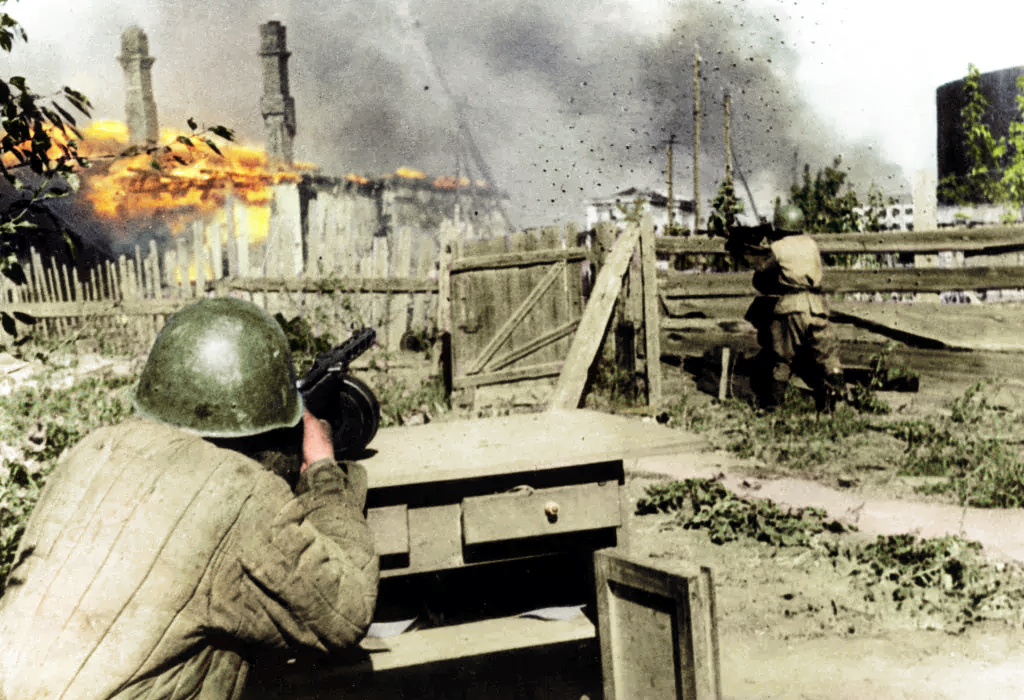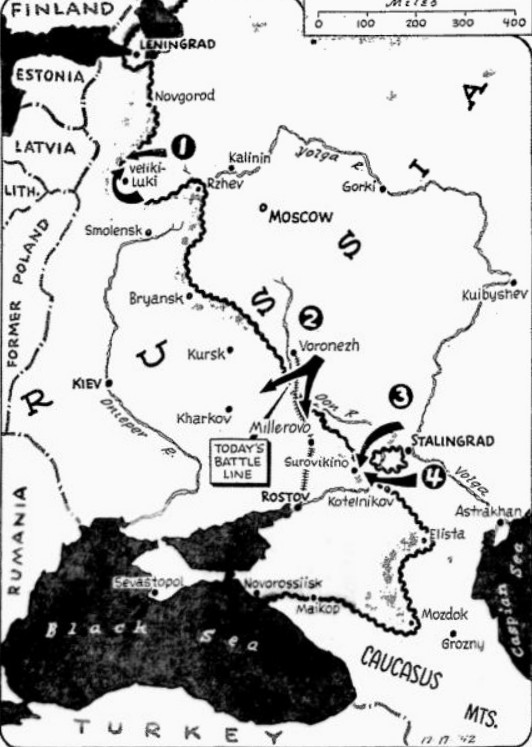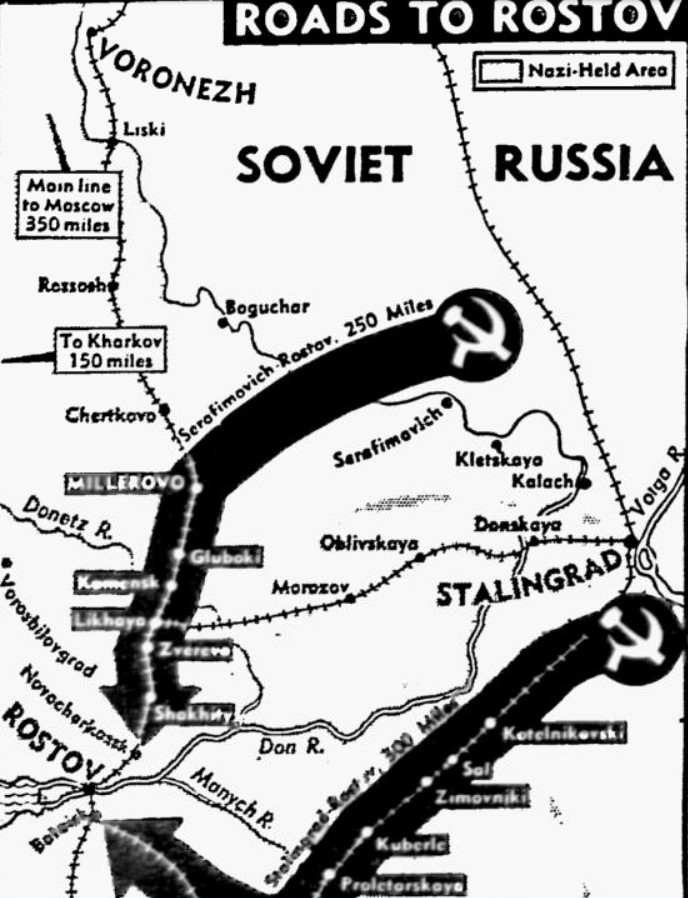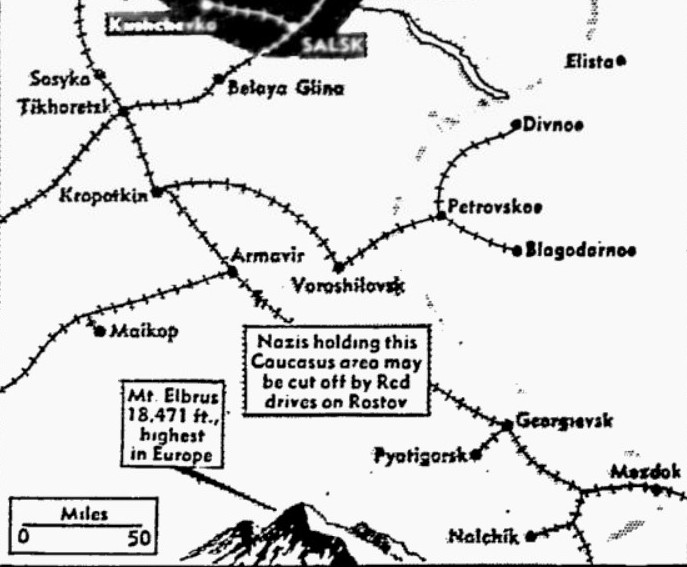Romanians’ wails follow great disaster in Russia
Axis toll already exceeds last winter’s; Hitler loses 400,000 men at Stalingrad; his ‘cannon fodder’ howls about ill treatment
By Henry Shapiro, United Press staff writer
Henry Shapiro, United Press Moscow manager, gives the first eyewitness account by an American of the disaster overtaking the Axis armies on the Stalingrad Front, in the following dispatch, second of a series.
With the Red Army on the Stalingrad Front, USSR – (Dec. 19, delayed)
For hundreds of square miles around this battleground in the Don River bend, there stretches a mammoth Axis graveyard.
Red Army salvage squads have been working day and night for weeks, removing war materials of all sorts to base points in the rear, whence they will be thrown into action against the enemy soon.
Burial squads have been collecting and burying the bodies of men which, along with those of horses and the wreckage of machines, lie in the snowdrifts, prey to carrion crews and wildcats.
Military police are rounding up tens of thousands of German and Romanian prisoners.
The moment I crossed the north bank of the Don to enter the territory wrested from Germans and begin a tour toward the east bank where Gen. I. M. Chistyakov’s 21st Red Army is steadily pressing the Germans toward the Volga, it became evident that the Axis had suffered an immense rout.
The Axis losses already surpass those of last winter when the Red Army made its first historic and crushing winter offensive.
My observation confirms reports that the Germans bore the brunt of casualties in the battle which is estimated to have cost the Axis so far 400,000 men killed, wounded or captured.
But the Romanians, in their small segment of the line, have suffered perhaps the greatest military disaster in their modern history, one which may prove catastrophic to Romanian home morale.
Romania had lost enormously in previous operations, probably more than any other Axis vassal. Romanians were put in the frontline from the very start. They lost heavily at Odessa and at Sevastopol.
This time, they were crushed. Scores of Romanian prisoners, officers and men, talked to me as they were escorted as prisoners toward the rear.
An infantry colonel said:
When the people at home learn the real extent of our tragedy, there will be hell to pay. It may mark the beginning of the end of Antonescu. [Marshal Ion Antonescu is the pro-Axis Romanian dictator.]
I met my first batch of Romanians at a railroad junction northwest of Stalingrad not far from the front. A whole trainload of assorted Axis prisoners was being shipped to prison camps. The Russians had seen so many German and Romanian prisoners, that they paid little attention to this batch.
An elderly Romanian general, in a gaudy comic opera uniform, escorted by a Red Army lieutenant, was pacing up and down the railroad platform, chewing sunflower seeds.
The general was awaiting the Russian equivalent of a Pullman car, allotted by the Red Army to high Axis officers though many Russian officers ride in boxcars because of rail congestion.
Weird apparitions pass by
For day after day, thereafter, I saw thousands of Romanians captured in this sector alone, weird apparitions in green uniforms with cone-shaped fur caps drawn over their ears, choking the snowclad roads and village streets. They marched four abreast in groups of several hundreds each. Russian motor vehicles passed back and forth, ignoring them.
The prisoners replied eagerly to my questions when they learned I was an American newspaperman. One clear impression emerged:
Romanians from generals to privates feel not only that they have been defeated but they have been misled by the Germans and their own leaders, and that their country and the Axis are doomed.
Give Reds much information
Whether these stories were told from conviction or to seek favor, it was impossible to tell.
But Russian Brigade Commissar Alexander Vorobiv told me that the Romanians had given the Red Army valuable military information.
“Hitler kaput – Antonescu kaput,” has become a universal greeting phrase of these prisoners, who always try to start conversations with the Russians they meet. They proceed to tell tales of woe and misery, to proclaim the existence of open enmity between themselves and the Germans. Their first complaint usually is of mistreatment by the Nazis.
Kaput, in rough translation, means “through” – Hitler and Antonescu are through.
I talked to five Romanian peasants from the Jassy district, in the Bessarabia area, who, like many others, surrendered with the Russians encircled them after the Germans seized all cars and fled, abandoning them to their fate.
Peasants denounce Germans
These peasants bitterly denounced the Germans for their superior airs, for underfeeding them – they said they were given the leavings from the German mess – and for using them as cannon fodder while Hitler despoiled Romania.
They stood in a snow-carpeted street, without gloves, blue with cold, shivering in thin unlined coats, ersatz leather shoes and cotton leggings. Three wore sheepskin caps. Two wore caps drawn down over their temples. I was to learn later that these representative Romanians were better-clad and better-equipped for the winter than the Germans.
Romanians said they were bewildered to find themselves fighting Russians, with whom for a century they had been allied against the Turks, and in World War I against the Germans.
A divisional commander, a general who admitted that he admired Antonescu, told me:
It was a great mistake for us to enter the war against the Russians. They have always been our allies. We have no hatred for them. This may be our ruin. We came on orders from above. Romanians as a whole oppose the alliance with the Germans, whose only supporters are the [Romanian Nazi] Iron Guards.
General describes his surrender
Many of our staff officers objected to sending our troops so far and opposed Hitler’s demand for 25 divisions for the Russian front. Our Chief of Staff was removed.
The general told of his surrender. He said that while he was discussing terms with a Russian negotiator who had brought him a Red Army ultimatum, he received an order from the German High Command ordering further resistance. But Russian tanks had already penetrated his rear and his officers and men were in panic and beginning a wholesale abandonment of their arms.
The general said shamefacedly:
Incidentally, I must apologize for the behavior of my orderly. He picked the pocket of the Soviet negotiator and stole his watch.
There is an air of suspicion at the front regarding the loud protests of the Romanians that they really like the Russians, because of the Romanians’ conduct before their surrender.
Villages which they occupied along the south arm of the Don bend present the same picture of ruin and desolation as those held by the Germans and Italians.
Every peasant hut and barnyard has been stripped bare. Not a single chicken was left in any village I visited. Scores of ruined villages testified to a brutality and plundering equaling if not surpassing that of the Germans.
On the roofless walls of huts in a village where prisoners were being interviewed were still plastered orders by the Romanian commandant:
IT IS HEREBY ORDERED: Inhabitants on whom soldiers are billeted are held responsible for their security. Any attempt on a Romanian soldier will be punished by shooting the chief of the household, the family and neighbors.
Among the piles of Romanian arms and equipment captured by the Russians, I found a large assortment of homespun Russian clothes, sewing machines, blankets, even children’s shoes.
A Romanian sergeant commented:
It was silly gathering all this loot. The Germans would have confiscated it anyway.
Prisoners are fed well
It might have been expected that the Russian people in liberated villages would show little charity to now-helpless individual prisoners. The contrary is true.
Groups of prisoners are fed by the Red Army at feeding posts set up at regular intervals along the road to the rear. The prisoners receive the same rations as Russian soldiers.
The prisoners say the rations are better than those of their own armies. Prisoners are given two pounds of bread a day compared with the half-pound given the Germans encircled outside Stalingrad.
It is the official Russian government policy to treat prisoners humanely. I have seen that policy carried out. Moreover, prisoners themselves have confirmed the extraordinary restraint of the Russians.
Repeatedly I saw prisoners, some still wrapped in plundered Russian shawls and blankets, enter peasant huts and piously intone:
Antonescu and Hitler kaput. Give me some bread.
Faced by starved, half-frozen men, the Russians appeared unable to show them the door.
Prisoners ‘are a nuisance’
I asked a peasant woman why she was feeding two Romanians who had entered her house late one evening. She had lost two sons at the front. Her daughter had been carried off to Germany. She said:
It’s not their fault. Only one man is guilty of our misfortunes. That is Hitler. They have occupied our territory and murdered and tortured and robbed. But we are not like that.
This woman’s big annoyance was that so many filthy strangers had cluttered her village. She said:
I wish they had stopped taking so many prisoners. They certainly are a nuisance.
A discharged Cossack cavalryman, who had escaped from a German prison camp after 29 of his comrades had been coldly machine-gunned, offered the same justification for his kindness to prisoners:
We aren’t like that.
My traveling companion, Lt. Col. Anatoly Tarantseve, said:
It is incurable. It is the so-called Russian soul. What we need is more fierce hatred of our implacable, inhuman enemy.






